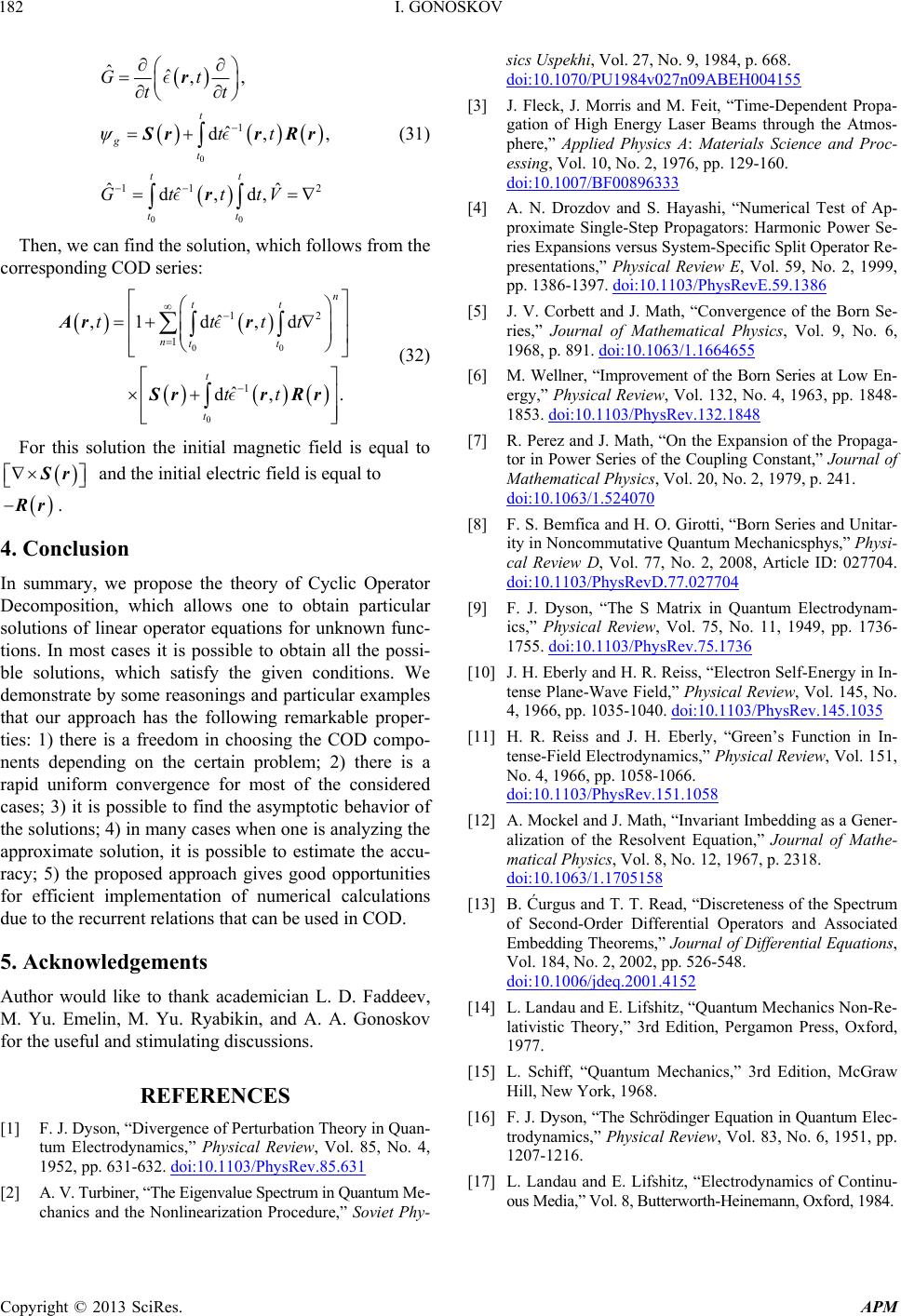
I. GONOSKOV
Copyright © 2013 SciRes. APM
182
0
11
ˆˆ
ˆ
ˆˆ
d,
t
g
t
Gt
tt
Gt
r
00
1
2
,,
d, ,
ˆ
d,
tt
tt
tt
ttV
r
r
rRr
0
12
,d
d, .
n
tt
t
tt
tt
r
r Rr
(31)
Then, we can find the solution, which follows from the
corresponding COD series:
0
0
1
1
ˆ
,1 d
ˆ
nt
t
t
tt
Ar
Sr
(32)
For this solution the initial magnetic field is equal to
r
Rr
and the initial electric field is equal to
.
4. Conclusion
In summary, we propose the theory of Cyclic Operator
Decomposition, which allows one to obtain particular
solutions of linear operator equations for unknown func-
tions. In most cases it is possible to obtain all the possi-
ble solutions, which satisfy the given conditions. We
demonstrate by some reasonings and particular examples
that our approach has the following remarkable proper-
ties: 1) there is a freedom in choosing the COD compo-
nents depending on the certain problem; 2) there is a
rapid uniform convergence for most of the considered
cases; 3) it is possible to find the asymptotic behavior of
the solutions; 4) in many cases when one is analyzing the
approximate solution, it is possible to estimate the accu-
racy; 5) the proposed approach gives good opportunities
for efficient implementation of numerical calculations
due to the recurrent relations that can be used in COD.
5. Acknowledgements
Author would like to thank academician L. D. Faddeev,
M. Yu. Emelin, M. Yu. Ryabikin, and A. A. Gonoskov
for the useful and stimulating discussions.
REFERENCES
[1] F. J. Dyson, “Divergence of Perturbation Theory in Quan-
tum Electrodynamics,” Physical Review, Vol. 85, No. 4,
1952, pp. 631-632. doi:10.1103/PhysRev.85.631
[2] A. V. Turbiner, “The Eigenvalue Spectrum in Quantum Me-
chanics and the Nonlinearization Procedure,” Soviet Phy-
sics Uspekhi, Vol. 27, No. 9, 1984, p. 668.
doi:10.1070/PU1984v027n09ABEH004155
[3] J. Fleck, J. Morris and M. Feit, “Time-Dependent Propa-
gation of High Energy Laser Beams through the Atmos-
phere,” Applied Physics A: Materials Science and Proc-
essing, Vol. 10, No. 2, 1976, pp. 129-160.
doi:10.1007/BF00896333
[4] A. N. Drozdov and S. Hayashi, “Numerical Test of Ap-
proximate Single-Step Propagators: Harmonic Power Se-
ries Expansions versus System-Specific Split Operator Re-
presentations,” Physical Review E, Vol. 59, No. 2, 1999,
pp. 1386-1397. doi:10.1103/PhysRevE.59.1386
[5] J. V. Corbett and J. Math, “Convergence of the Born Se-
ries,” Journal of Mathematical Physics, Vol. 9, No. 6,
1968, p. 891. doi:10.1063/1.1664655
[6] M. Wellner, “Improvement of the Born Series at Low En-
ergy,” Physical Review, Vol. 132, No. 4, 1963, pp. 1848-
1853. doi:10.1103/PhysRev.132.1848
[7] R. Perez and J. Math, “On the Expansion of the Propaga-
tor in Power Series of the Coupling Constant,” Journal of
Mathematical Physics, Vol. 20, No. 2, 1979, p. 241.
doi:10.1063/1.524070
[8] F. S. Bemfica and H. O. Girotti, “Born Series and Unitar-
ity in Noncommutative Quantum Mechanicsphys,” Physi-
cal Review D, Vol. 77, No. 2, 2008, Article ID: 027704.
doi:10.1103/PhysRevD.77.027704
[9] F. J. Dyson, “The S Matrix in Quantum Electrodynam-
ics,” Physical Review, Vol. 75, No. 11, 1949, pp. 1736-
1755. doi:10.1103/PhysRev.75.1736
[10] J. H. Eberly and H. R. Reiss, “Electron Self-Energy in In-
tense Plane-Wave Field,” Physical Review, Vol. 145, No.
4, 1966, pp. 1035-1040. doi:10.1103/PhysRev.145.1035
[11] H. R. Reiss and J. H. Eberly, “Green’s Function in In-
tense-Field Electrodynamics,” Physical Review, Vol. 151,
No. 4, 1966, pp. 1058-1066.
doi:10.1103/PhysRev.151.1058
[12] A. Mockel and J. Math, “Invariant Imbedding as a Gener-
alization of the Resolvent Equation,” Journal of Mathe-
matical Physics, Vol. 8, No. 12, 1967, p. 2318.
doi:10.1063/1.1705158
[13] B. Ćurgus and T. T. Read, “Discreteness of the Spectrum
of Second-Order Differential Operators and Associated
Embedding Theorems,” Journal of Differential Equations,
Vol. 184, No. 2, 2002, pp. 526-548.
doi:10.1006/jdeq.2001.4152
[14] L. Landau and E. Lifshitz, “Quantum Mechanics Non-Re-
lativistic Theory,” 3rd Edition, Pergamon Press, Oxford,
1977.
[15] L. Schiff, “Quantum Mechanics,” 3rd Edition, McGraw
Hill, New York, 1968.
[16] F. J. Dyson, “The Schrödinger Equation in Quantum Elec-
trodynamics,” Physical Review, Vol. 83, No. 6, 1951, pp.
1207-1216.
[17] L. Landau and E. Lifshitz, “Electrodynamics of Continu-
ous Media,” Vol. 8, Butterworth-Heinemann, Oxford, 1984.